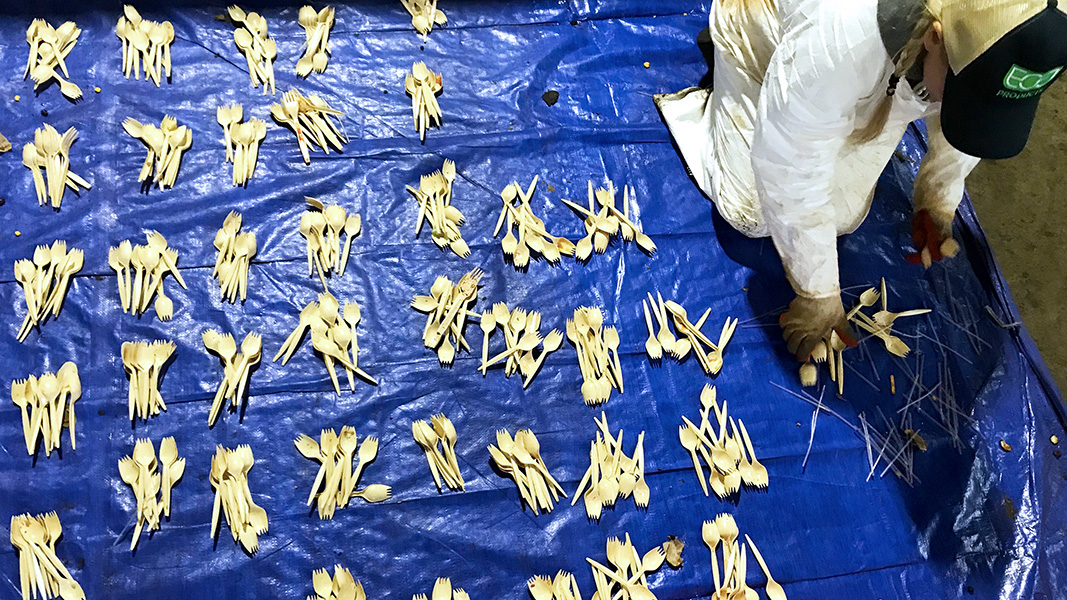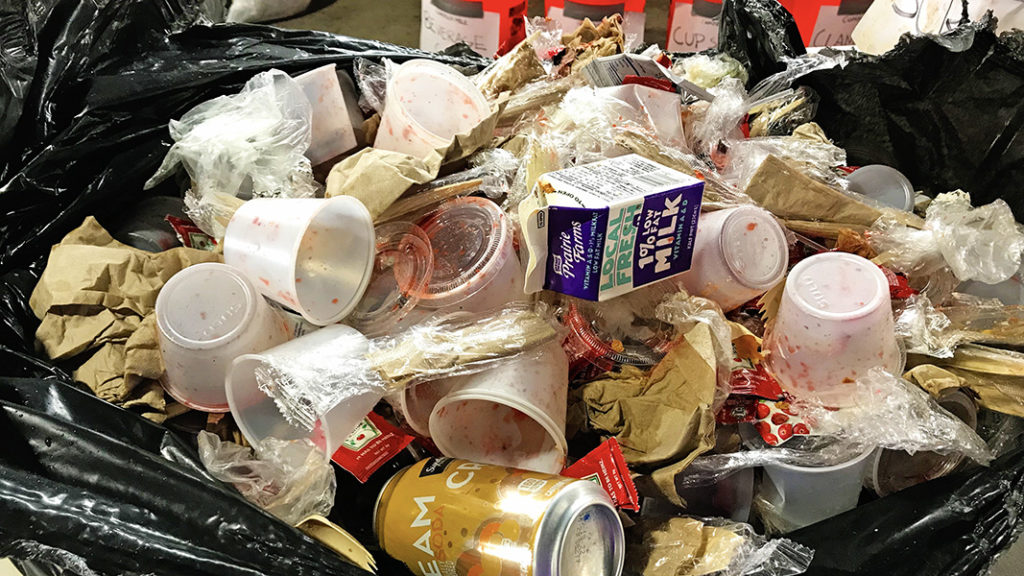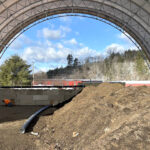Top: Compostable cutlery was sorted from front-of-house food scraps bins at venues participating in the CompostAble Chicago study. Photo courtesy of Resource Recycling Systems (RRS)
Nora Goldstein
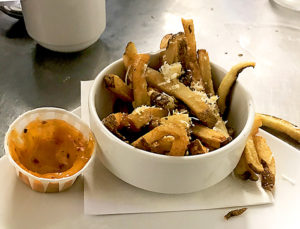
Food scraps prior to being scraped into the composting-bound bin at a venue. Photo courtesy of Bright Beat
Does the adoption of compostable foodservice packaging, implemented under the right operating conditions, correlate to increased capture of Front-of-House food scraps with minimized contamination? That was the “motivating question” underlying a 2022 field research project, “CompostAble Chicago,” sponsored by the Foodservice Packaging Institute in collaboration with the Biodegradable Products Institute, Eco-Products, Illinois Food Scrap & Composting Coalition, Plant Based Products Council, and Sustainable Packaging Coalition. The project aimed to understand how the use of compostable foodservice packaging in front-of-house (FOH) composting programs correlates with capture of food scraps, and contamination levels in the composting-bound stream.
One of the desired outcomes of the study was to develop a methodology for characterizing best practices related to use of compostable foodservice items, and then measuring the effect of best practices on levels of contamination and food capture. Resource Recycling Systems (RRS) and Bright Beat, the project team, assessed best practices for FOH composting programs at four Chicago foodservice operations. The facilities’ waste streams were characterized, including material destined for composting.
Venue Selection
Four different types of foodservice venues were screened and selected to serve as a real-world data collection site. Prior to selection for the study, venues were assessed for the number of distinct compostable items they use; whether they had FOH organics collection for composting; estimated amount of material generated in a week; whether waste stays on site (i.e., dine-in); and operating conditions for use of compostable items.
The selected venues included:
- Full-Service Restaurant: 40 staff; serve 200 to 300 meals/day; 75% to 100% of meals consumed on-site
- Quick Serve at Museum (fast food and fast casual): serve 600 meals/day; 75% to 100% of meals consumed on-site
- Self-Serve at School Cafeteria: serve 925 meals/day; 75% to 100% of meals consumed on-site
- Quick Serve at University Café (fast food and fast casual): 280 transactions (vs. meals)/day, including coffee; 75% to 100% of meals consumed on-site
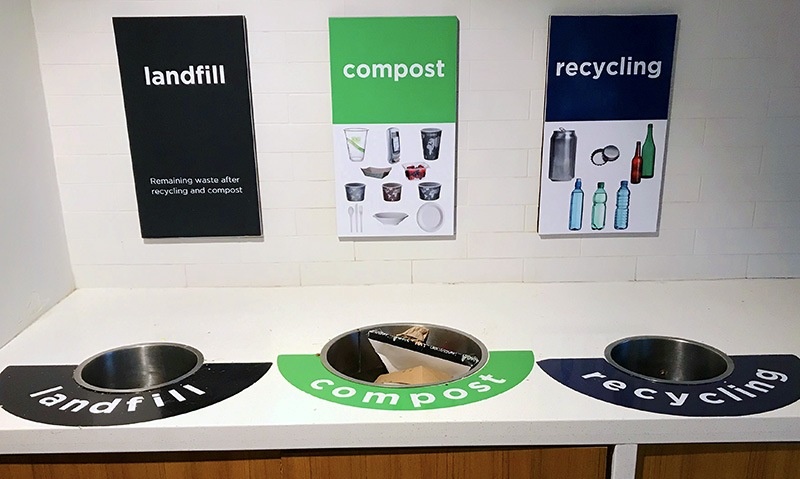
Venues were assessed for clarity of guidance, e.g., signage, at front-of-house sorting stations. Photo courtesy of Bright Beat
Best practices conditions at each venue were assessed using four “framework dimensions” — procurement, operations, communications, and people. Scores were assigned from 1-5 based on a series of specific attributes that underly those four framework dimensions. For example, the procurement assessment evaluated the proportion of single-use foodservice packaging that is compostable. At the full-service restaurant, 12 out of 12 of the single-use foodservice items are compostable (score of 5). Conversely, at the school cafeteria, 2 out of 11 of the items are compostable (score of 1).
With operations, the venues were assessed on four independent variables: FOH stream management (i.e., does the facility actively sort or review FOH streams for contamination?); minimization of outside materials (items not used by the venue); targeted programs or protocols to improve food capture and successful implementation of use of compostable items; and staff training (i.e., are staff equipped to recognize and differentiate compostable vs. noncompostable items?). The museum café and school cafeteria received scores of 18 out of 20 and 16 out of 20 on the operations dimension, respectively. The full-service restaurant scored a 20 out of 20, while the university café scored 10 out of 20.
Independent variables in the communications dimension are labeling, patron messaging, and culture and commitment. For the people dimension, the variables are whether the venue patrons have frequent exposure to the guidance and communications about FOH accepted items and proper sorting; and if the venue benefits by having knowledgeable and experienced staff. When the scores for all four dimensions were combined (total of 65 points could be awarded), the full-service restaurant’s score was 54; the other venues’ scores ranged from 45 to 49.
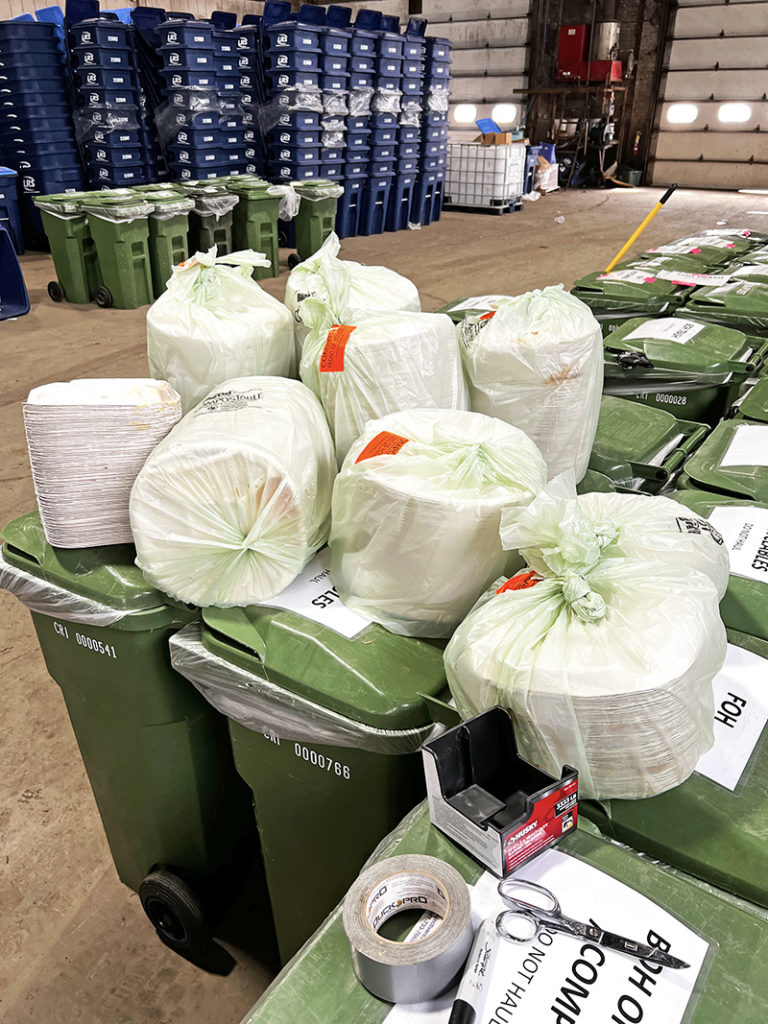
All front-of-house and back-of-house carts from the venues were taken to a waste sorting location. Soiled fiber plates in foreground. Photo courtesy of RRS
Venue Waste Characterizations
The Project Team collected and sorted sample waste from each venue to quantify the amount of foodservice packaging and food scraps in each stream. Sampling, sorting, weighing, and otherwise measuring the materials in each stream (e.g., FOH and back-of-house (BOH) compost, trash, and recycling) allowed the Project Team to measure quantities of items relative to each other by weight and volume; provide food scraps capture and contamination data once sorted (measured by the amount of materials correctly disposed of in the stream divided by the total amount in that stream); and compare quantities and capture rates across venues.
At the full-service restaurant, the FOH compostables bin and the BOH compostables, trash and recycling streams were sorted. At the museum café, FOH compostables and recycling bins were sorted, and the BOH trash. At the school cafeteria and university café, FOH compostables, trash and recycling, and BOH compostables and trash were sorted. The CompostAble Chicago study report includes data on contamination (% by weight), food capture (% by weight) and top materials found in the FOH compostables streams. At the full-service restaurant, for example, compostable clamshells represented 16.2% by volume and 0.9% by weight.

Bags from the composting-bound bins were opened and sorted into food scraps, compostable foodservice ware, and contaminants. Photo courtesy of RRS
Findings
The findings fall into two general buckets: Waste stream sort data and influence of best practice conditions on the amount of food scraps captured and the amount of contamination in the compostables bin. In terms of the waste stream sort data, the study found that food scraps and compostable items, by weight, are the largest component of the FOH compostables streams. For the highest scoring venue (full-service restaurant), food scraps were found to be, by a wide margin, the largest component of the compostables stream. Food scraps were generally found in FOH compostables streams to be more predominant than compostable packaging materials. Significant amounts of food scraps and compostable packaging were identified in all trash streams, however FOH trash streams were not able to be sampled from the restaurant and the museum.
Contamination levels in the FOH compostables streams varied significantly from exceptionally low levels to moderate levels. At the museum and university cafés, the FOH compostables bins had more contaminants by weight and volume. Food scraps (including liquids) and compostable items made up about half of FOH trash at the school cafeteria and university café. Locations with high patron turnover (museum and café) collected the most contamination. Contaminants were constituted primarily of high quantities of plastic cups, plastic utensils, plastic bags, and residue.
With regard to the influence of best practices, the project team concluded that across venues sampled, food scraps capture in FOH compostables trended higher at venues with higher levels of best practice operating conditions (i.e., the four dimensions in the framework). The findings suggest that properly managed FOH waste streams would be expected to contain more food than compostable packaging. The team’s hypothesis that venues utilizing compostable foodservice packaging under the right operating conditions should be expected to have less contamination in the FOH compostables streams was proven out by the data.
Another finding of the study is that contamination levels generally trend lower with stronger adoption of compostable foodservice items. For example, much of museum’s contamination was likely noncompostable substitutes for compostable items ordered but not received due to supply chain disruptions.
The CompostAble Chicago study report is available by download at this link.


